To celebrate its 40th birthday, ARB threw an epic off-road adventure party.
It bought, fixed and equipped four iconic 4x4s before sending them off on its ARB Off-Road Icons trip. We were lucky enough to score an invitation.
For more info on the vehicles we took to the Simpson, check out the ARB Off-road Icons.
Here's how the adventure unfolded.
RAIN DREAMING
THE Supp Regs were outlined on the first morning as we munched on egg and bacon rolls atop Alice Springs’ ANZAC Lookout. Sam Boden ran through the route, which would see us travel from Alice Springs to Chambers Pillar and then on to Mt Dare, before traversing the Simpson Desert via Dalhousie Springs, the French Line, the Rig Road, Knolls Track, back on to the French Line, Poeppel Corner, the QAA Line, and on to Birdsville.
The plan was to then head to Cordillo Downs, Coongie Lakes, Innamincka, Burke’s Grave, the Burke and Wills Dig Tree, Cameron Corner, Tibooburra, Milparinka, Packsaddle, Silverton, Eldee Station and then on to Broken Hill, where the trip would officially conclude some two weeks after it began… weather permitting.
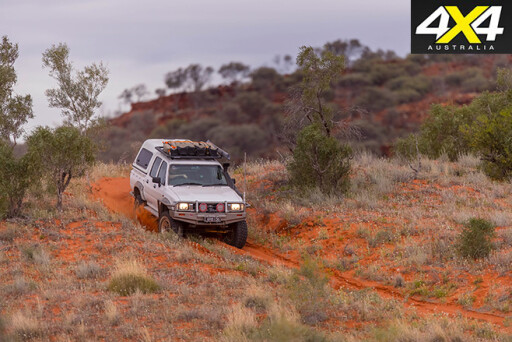 The sky was grey with ominous-looking clouds as we departed Alice Springs, and the weather forecast wasn’t great; a series of cold fronts were pushing their way across Central Australia from the southwest and they were supposedly going to bring plenty of rain. However, the skies began to clear as we headed out of Alice Springs on Old South Road and hit the gravel for the first time.
The sky was grey with ominous-looking clouds as we departed Alice Springs, and the weather forecast wasn’t great; a series of cold fronts were pushing their way across Central Australia from the southwest and they were supposedly going to bring plenty of rain. However, the skies began to clear as we headed out of Alice Springs on Old South Road and hit the gravel for the first time.
As the crew began to familiarise themselves with the vehicles, there was plenty of radio chatter. The occupants of the FJ40 were already wishing they’d packed earplugs, with the windows rattling furiously in their doors and the loose tailgate adding to the cacophony. The ambience inside the Defender was much calmer – although by today’s NVH standards it was still appalling, with rattles, squeaks and groans emanating from just about every part of the vehicle, except for that new 300Tdi engine which sounded fantastic and was blessed with copious amounts of low-rpm grunt.
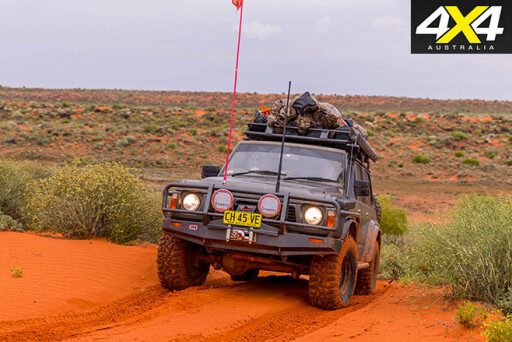 The GQ Patrol and the LN106 Hilux were positively serene by comparison – with windows up and air conditioners on, noise levels inside these two Icons weren’t that far off modern-vehicle standards.
The GQ Patrol and the LN106 Hilux were positively serene by comparison – with windows up and air conditioners on, noise levels inside these two Icons weren’t that far off modern-vehicle standards.
We stopped off at Ewaninga Rock Carvings on the way south where there is the Northern Territory’s highest concentration of petroglyphs. An information sign here includes a quote from a local regarding the ‘Rain Dreaming’, which states: “Big storm through here, big mobs of thunder and lightning and all that…” Considering the weather forecast, I thought maybe this could be a sign of things to come.
By the time we arrived at Chambers Pillar the sky had once again started to fill with clouds. There was still an hour or more of light as we rolled out our swags for the first time and set about unloading the firewood we’d collected earlier in the day. As we got the fire going, Vicky cooked up our first meal, while Patrick cracked open a bottle of single malt whisky to celebrate the start of a new adventure.
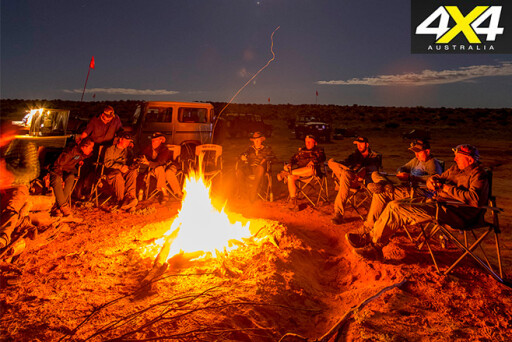 Of course, this was all washed down with the obligatory ration of beers and then, after dinner, a few of us took the opportunity for a night-time walk around Chambers Pillar, just as it started to rain.
Of course, this was all washed down with the obligatory ration of beers and then, after dinner, a few of us took the opportunity for a night-time walk around Chambers Pillar, just as it started to rain.
The sky was cloudy again the next morning, but the rain had stopped – in fact, there had only been a light sprinkle overnight – and the clouds began to vanish as we ate brekky. After a stint in the Defender the previous day, I opted to go for a run in the GQ Patrol this morning; I had been itching to reacquaint myself with the Patrol after having driven it in standard form more than a year earlier. Now, with its aftermarket turbo and new Old Man Emu suspension, it was a far cry from the tired old beast it once was. It positively hauled!
We headed back out to Maryvale and then on to the Ghan Heritage Road, which became more and more corrugated as we headed south; in fact it was starting to feel a little uncomfortable in the Patrol, so it must’ve been positively diabolical (and deafening) in the rattly old FJ.
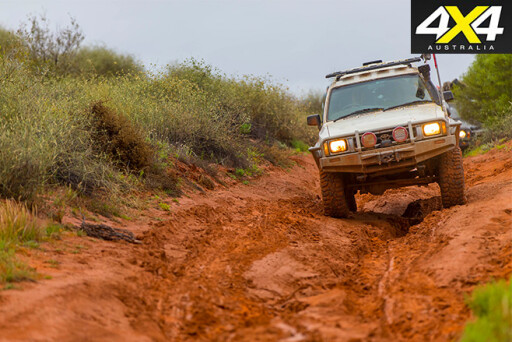 We had reached the Finke River by lunchtime, where we pulled up to regroup the convoy and have a bite to eat. I jumped into the LN106 Hilux after lunch and was amazed by the lack of squeaks and rattles despite the relatively poor condition of the road, including the final section of whoops on the Finke Desert Race track into Finke. Toyota’s build quality in the mid-1990s was second-to-none, and this Hilux was built in the middle of that period. It was also very well-prepared for this trip by Roger Vickery’s ARB Queensland team.
We had reached the Finke River by lunchtime, where we pulled up to regroup the convoy and have a bite to eat. I jumped into the LN106 Hilux after lunch and was amazed by the lack of squeaks and rattles despite the relatively poor condition of the road, including the final section of whoops on the Finke Desert Race track into Finke. Toyota’s build quality in the mid-1990s was second-to-none, and this Hilux was built in the middle of that period. It was also very well-prepared for this trip by Roger Vickery’s ARB Queensland team.
We pushed on towards Mt Dare thinking that the final muddy section just before the pub might be a bit tricky. Earlier in the day we’d chatted to some people who’d just left Mt Dare and they said it was a struggle, and the mud covering their vehicles seemed to confirm this.
Nevertheless, we made it through the wet section easily enough and were soon chin-wagging at the bar with hotel proprietors Graham and Sandra Scott. They told us to expect some more rain overnight and organised for a sheltered area to be cleared where we could roll out our swags.
 After another light overnight drizzle, it was quite a challenge trying to walk around a muddy and slippery Mt Dare in the morning. However, by the time we’d had breakfast, refuelled the vehicles, and packed and loaded our gear, the sun was out and the ground had started to dry.
After another light overnight drizzle, it was quite a challenge trying to walk around a muddy and slippery Mt Dare in the morning. However, by the time we’d had breakfast, refuelled the vehicles, and packed and loaded our gear, the sun was out and the ground had started to dry.
INTO THE DESERT
WITH only a relatively short drive to Dalhousie Springs we could afford a leisurely start, and it was 10.30am by the time we departed Mt Dare. We stopped off for a look around Bloods Creek Ruins, where a fellow by the name of Gillen stopped in 1901, describing the pub here as “a miserable little store eating house and grog shanty kept by a man named Harvey; found half a dozen men there including the proprietor all more or less drunk – principally more.”
After the settlement was abandoned, Bloods Creek was leased to Edmund (Ted) Colson in 1931, the first European to cross the Simpson Desert. He was accompanied by Eringa Peter (Peter Ains) of the Antakurinya tribe, and in 1936 the pair completed the 885km round trip from Bloods Creek to Birdsville and back in just 35 days. He was apparently prompted to cross the desert by an ‘exceptionally wet season’, which sounded very similar to the conditions we were now experiencing 80 years later.
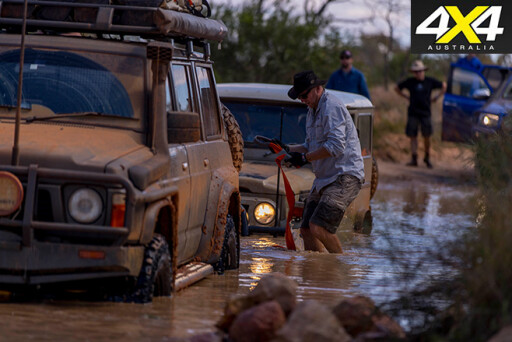 We were soon confronted by our first deep-water crossing. The petrol-powered FJ40 didn’t like it at all, and as soon as water splashed up into its engine bay the fire went out. After towing the FJ out of the drink with the Patrol, we dried the distributor, coil and leads and soon had the engine purring again. The other vehicles all made it through okay, but the deep water certainly tested the Defender’s door seals, which failed entirely to keep water out of the cabin.
We were soon confronted by our first deep-water crossing. The petrol-powered FJ40 didn’t like it at all, and as soon as water splashed up into its engine bay the fire went out. After towing the FJ out of the drink with the Patrol, we dried the distributor, coil and leads and soon had the engine purring again. The other vehicles all made it through okay, but the deep water certainly tested the Defender’s door seals, which failed entirely to keep water out of the cabin.
After a few more wet and muddy sections we arrived at Dalhousie Springs in the mid-afternoon to find we had the place to ourselves. Not another visitor in sight… nada. After rolling out our swags we did what everyone does when they first arrive at Dalhousie Springs: we went for a dip in the warm waters of the mound springs, heated to a very pleasant 34-38°C by the ancient waters rising from the Great Artesian Basin.
 We floated around for a couple of hours, discussing the adventure so far, how we thought the vehicles were performing, what the weather might do, how fortunate we were to be here, and what Vicky might be preparing for dinner. Yep, we were having a hell of a great time so far. The menu that night far exceeded anyone’s expectations: fresh oysters for entrée and a selection of kangaroo, lamb, beef and emu for the main course. Scrumptious.
We floated around for a couple of hours, discussing the adventure so far, how we thought the vehicles were performing, what the weather might do, how fortunate we were to be here, and what Vicky might be preparing for dinner. Yep, we were having a hell of a great time so far. The menu that night far exceeded anyone’s expectations: fresh oysters for entrée and a selection of kangaroo, lamb, beef and emu for the main course. Scrumptious.
Knowing we were about to spend the next three days in the desert, the following morning a few of us took the opportunity to indulge in a final swim in the mound springs. We were fed, packed and ready to roll by 9am and were soon on the move.
We’d only driven around 30km along Spring Creek Track when the convoy was called to a halt. The trailer had suffered its first major mechanical failure.
The centre pin had broken on the right-hand leaf pack and a couple of leaves had fallen out. As a result, the axle had moved and the tyre was rubbing on the guard. Luckily the boys had thought to pack a spare leaf spring pack and, with the help of ‘expert’ onlookers, David Cox sorted the problem while we whittled away our idle time by fitting sand flags and drinking freshly brewed coffee – all in all another very enjoyable morning.
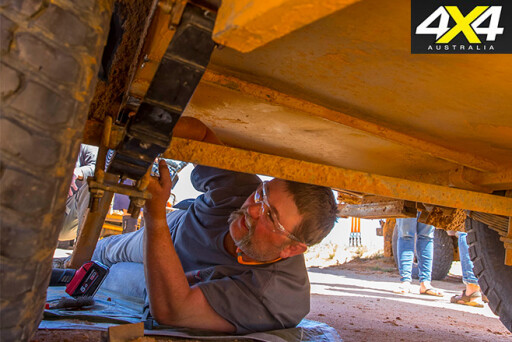 The trailer issue had put us slightly behind schedule and it was 2pm by the time we pulled up at Purni Bore for lunch. It was a sunny afternoon and the mercury was nudging the mid-20s, which was about perfect considering two of the vehicles – the FJ40 and Defender – were not equipped with air conditioning. Their white roofs, vertical glass and excellent ventilation flaps, however, proved more than adequate on the cooling front.
The trailer issue had put us slightly behind schedule and it was 2pm by the time we pulled up at Purni Bore for lunch. It was a sunny afternoon and the mercury was nudging the mid-20s, which was about perfect considering two of the vehicles – the FJ40 and Defender – were not equipped with air conditioning. Their white roofs, vertical glass and excellent ventilation flaps, however, proved more than adequate on the cooling front.
Later that afternoon we arrived at the desert-proper and crested what looked like could have been the first of the claimed 1100-plus parallel sand dunes that make up the Simpson Desert. By this stage we had dropped tyre pressures to around 16psi and were soon heading south on Rig Road. We pulled up the convoy at 6.30pm and set up camp under clear skies.
Patrick asked Michael to get a shot of the Defender on a dune with the full moon in the background, and the resultant pic is definitely one destined to go ‘straight to the poolroom’.
 Michael, Adam and I then headed off-piste to recce a suitable spot for a sunrise shot the next morning and, after enjoying a dune-top coldy, we headed back down to camp where an inviting fire was already ablaze. That night we spotted the first wispy white clouds pop over the western horizon, but Outside’s Wes Siler assured us there was no rain in them. As the night wore on, however, Wes’s wispy white clouds were replaced by sinister-looking rain clouds and, sure enough, it rained consistently throughout the night.
Michael, Adam and I then headed off-piste to recce a suitable spot for a sunrise shot the next morning and, after enjoying a dune-top coldy, we headed back down to camp where an inviting fire was already ablaze. That night we spotted the first wispy white clouds pop over the western horizon, but Outside’s Wes Siler assured us there was no rain in them. As the night wore on, however, Wes’s wispy white clouds were replaced by sinister-looking rain clouds and, sure enough, it rained consistently throughout the night.
When my alarm went off at 5am the rain had stopped and, despite the overcast sky, Michael, Adam and I still attempted the ‘sunrise’ shot we’d recced the previous evening, setting up the Defender atop the dune and waiting in vain for the sun to break through the clouds. It didn’t, so we spent most of our time that morning trying to keep a very expensive video camera dry with our jackets, while drinking coffee and watching the campsite below slowly come alive as people reluctantly crawled out of their cosy swags.
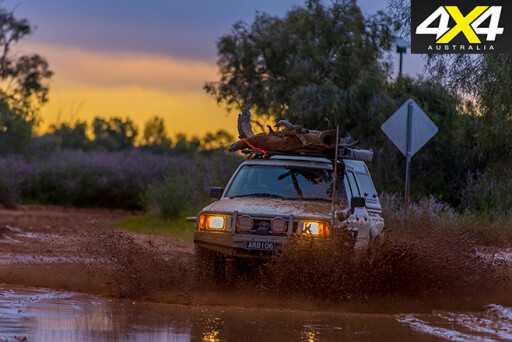 We joined the rest of the crew for breakfast and then set about packing up camp in the drizzling rain. We were on the move by 8.30am – our earliest start thus far – and as we continued east the rain started to ease. Nevertheless, the track was very wet in sections and quite muddy, so the convoy’s pace was limited by the FJ40, which had to be idled through the wetter sections for fear of getting water anywhere near its electrical system.
We joined the rest of the crew for breakfast and then set about packing up camp in the drizzling rain. We were on the move by 8.30am – our earliest start thus far – and as we continued east the rain started to ease. Nevertheless, the track was very wet in sections and quite muddy, so the convoy’s pace was limited by the FJ40, which had to be idled through the wetter sections for fear of getting water anywhere near its electrical system.
Once past Lynnies Junction, we were at last into the sandy section of the WAA Line. We turned off at Erabena Track and headed south to Lone Gum where we stopped for lunch, after which we headed back up to Rig Road and pointed east again.
I was driving the Defender at this stage and was becoming quite annoyed by the constant sounding of the thermo alarm. The engine certainly wasn’t overheating, but the alarm sounded nonetheless. I popped the bonnet to see if I could see what the problem was, and when Fred Williams wandered over for a quick squizz he soon spotted the offending loose wire connection. It’s amazing what you can do with a couple of cable ties: he jammed a part of one in the dodgy connection and used the other to secure it all together.
Now I could enjoy all of the Defender’s rattles and squeaks and groans without that incessant bloody alarm.
 We turned left on to Knolls Track and were heading north again, thinking we’d have enough daylight to make it back up to the French Line to find a suitable campsite for the night. But the going was quite rough, with lots of undulations testing the suspension on all of the vehicles. In fact, Sam Boden had pulled over to adjust the BP-51s on his Toyota Hilux, upping the front compression damping to smooth out the ride. Soon after we heard a call on the UHF from the tucker truck; it seemed we had another trailer problem.
We turned left on to Knolls Track and were heading north again, thinking we’d have enough daylight to make it back up to the French Line to find a suitable campsite for the night. But the going was quite rough, with lots of undulations testing the suspension on all of the vehicles. In fact, Sam Boden had pulled over to adjust the BP-51s on his Toyota Hilux, upping the front compression damping to smooth out the ride. Soon after we heard a call on the UHF from the tucker truck; it seemed we had another trailer problem.
This time the trailer’s coupling had failed – it had broken clean off! So we decided where it lay stranded was the perfect spot to set up camp. While David and Mark set about cleaning the coupling, we grabbed a couple of batteries out of the other vehicles for the boys to power the welder. While they made the repair, Vicky cooked another fabulous meal right where the trailer lay stranded in the middle of the track.
 We had to make up for lost time the next day, and once again Michael was keen to grab a sunrise dune shot, this time of the FJ40. Patrick and I jumped in the FJ and followed Michael and Adam north along Knolls Track at an agonisingly early 4.30am. It was still dark when we found a clear-enough dune to shoot on; with all the rain the desert was heavily vegetated, so finding a clear dune wasn’t easy.
We had to make up for lost time the next day, and once again Michael was keen to grab a sunrise dune shot, this time of the FJ40. Patrick and I jumped in the FJ and followed Michael and Adam north along Knolls Track at an agonisingly early 4.30am. It was still dark when we found a clear-enough dune to shoot on; with all the rain the desert was heavily vegetated, so finding a clear dune wasn’t easy.
The rest of the convoy was underway by 6.30am and we could soon hear them approaching via their chatter on the radio. I offered Michael a drive of the FJ40; despite his lanky frame hardly fitting in the cabin, he couldn’t resist the opportunity. He just about had to open the driver’s door to make enough space to move his foot across to the brake pedal. Adam and I could hear Michael and Patrick laughing their way across the dunes, but then the UHF went silent. The FJ40’s fire had gone out again, but this time there was no water crossing to be blamed for the stoppage.
 The rest of the convoy was soon with us, and on seeing the FJ40’s bonnet up they swarmed around like moths to a flame. David Cox soon had the multimeter out and discovered there was no power coming out of the coil. Several attempts were made to locate the fault, pulling wires off several components, reattaching them, and trying just about everything we could think of but, after close to two hours in the one spot, we had to admit defeat.
The rest of the convoy was soon with us, and on seeing the FJ40’s bonnet up they swarmed around like moths to a flame. David Cox soon had the multimeter out and discovered there was no power coming out of the coil. Several attempts were made to locate the fault, pulling wires off several components, reattaching them, and trying just about everything we could think of but, after close to two hours in the one spot, we had to admit defeat.
We were still 230km from Birdsville and we were going to have to tow the FJ40 the rest of the way across the Simpson Desert. This was really starting to become a proper adventure.
ARB’s Off-Road Icons trip continues next month!

COMMENTS